This Still May be a Dry Year for Us—or a Megadrought
I’m so happy to see rain again. Ever since the drought of 2011-2015, I worry about the next one. And while we’ve had a few good rain years, we are still in a tough time.
A scientific paper, published last spring, showed that California and much of the West is going through what’s called a megadrought. This is a drought that is decades long with low precipitation and soil moisture, reduced mountain snowpack, with less frequent wet years and drier dry years. This megadrought started in 2000 and it has been the second driest period for the past 1200 years.
While some areas and years still have above average rainfall and some cooler temperatures, the averages have been trending hotter and drier over the last 20 years. For more explanation and a graph, see https://www.ppic.org/blog/californias-21st-century-megadrought/ .
The study determined that rising temperatures from human caused climate change has greatly exacerbated the drought, making a milder drought into a much worse one. The higher temperatures suck the moisture out of plants and soils. And they cause earlier melting and evaporation of what snow pack we do get which makes less water available to some of the water systems we tap into.

Rainfall needs to soak into the soil to feed the plants and to recharge the aquifers
I’ve written about this before, but it bears repeating since this idea of a megadrought gives us a new sense of urgency. Our tap water may not always be abundantly available, as we glimpsed in 2015.
We may soon need to think differently about what happens to the water that falls on our land to make the best use of it. Now that we’ve finally gotten some much needed rain with more on the way, it’s a good time to look at how rainwater moves on our land.
If you take a look around you, you’ll see that our infrastructure channels water away from our properties. Down drainage ditches, with small drainage ditches merging into bigger ones, drainage pipes going under roads, pipes sending it all down to the nearest waterway as fast as it can go. Not much time to sink in.
It’s important to protect structures and roads from flooding, but downhill, water can be collected and allowed to sink in.
Rainfall on your land recharges your aquifer
If you’re on a well, your well gets recharged from rain soaking into your land. The rock layer below the soil allows water to trickle into aquifers. Send rainwater quickly away with paving, a poorly placed structure, or a drainage ditch and you miss much of the water that could get into your well.
How do you get more rainfall into your soil?
Slow it, spread it, and sink it.
First slow the rain water by protecting the soil with trees and other vegetation cover. Also with mulches like wood chips, straw, and compost.
Spread it where it is gathering and picking up speed by digging swales. These are depressions the run along the contour of a slope. They allow the water to fill and spread out along the swale giving it time to soak into the soil. In urban areas swales are planted with vegetation which helps filter litter and pollutants out to prevent them from getting to the rivers.
Sometimes spreading it can mean setting up some check dams to break the flow where water is running downhill. And that can allow it to accumulate to a reasonable amount, giving it time to soak in. Once the flow is slowed the water sinks in.
Another way of sinking comes from plant roots. Vegetation cover breaks and softens the impact of the rainfall and the roots help to carry the water down further into the soil.
Catching rainfall has been done with miraculous results
There are some beautiful success stories of people who have used water catching methods to take parched pieces of land and make them highly productive and to restore damaged ecosystems.
Please take some time to watch these three films on YouTube. “The Rainwater Harvester” is about a man with a family on an arid piece of land in Zimbabwe, who learned how to catch what little rainwater that fell on his land to sink it into the ground and ultimately was able to grow an impressive, productive farm.
The next, “Selah: Water from Stone” is about a man who bought the driest, rockiest piece of land he could find in Texas and used native grass plants to absorb the scant rainfall which restored the water table, ponds, and brought back a variety of wildlife.
And “The Miracle Water Village” shows how a drought-stricken farming village in India learned how to capture and sink the little rainfall they got to grow their crops and turn their destitution into abundance.
Megadroughts have occurred in the West throughout history and some have lasted a century.
If this is a megadrought and it continues we would be wise to start to learn and prepare so that we can make good use of whatever rainfall we get.
For some detailed techniques see the books by Brad Lancaster titled “Rainwater Harvesting for Drylands and Beyond, Volumes 1 and 2”.
Also see my previous article called A Looming Drought? Catch Rainfall Now and Recharge Your Well & Soil.


Doreen, this was such an informative article. Coming from Tahoe, I’ve learned about water issues from the standpoint of controlling erosion and nutrients from “turning the lake from blue to green” and I wasn’t sure how to deal with water use here in the foothills of Grass Valley. It seems that permeation rather than runoff is also needed here. I loved the idea of creating swales which could then be planted. One problem I never expected on buying property in GV is that the extremely hot summers would require constant irrigation (we needed it in Tahoe but the season is very short.) I’ll be getting in touch soon to hire you as a consultant on how to landscape responsibly.
I’m glad you enjoyed and learned something from my article! That’s what I hope for. I look forward to connecting with you.